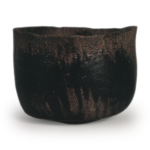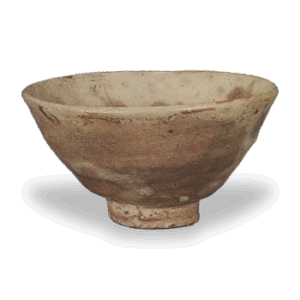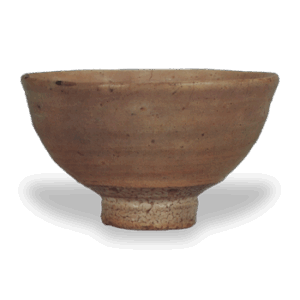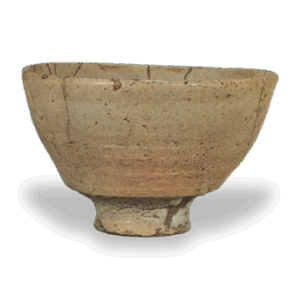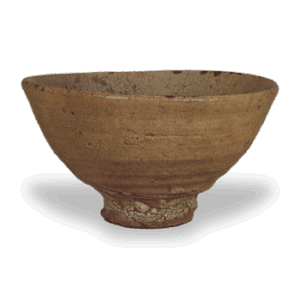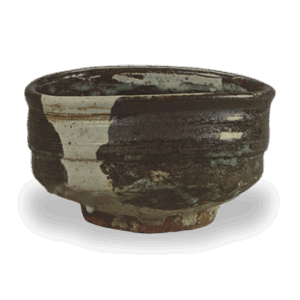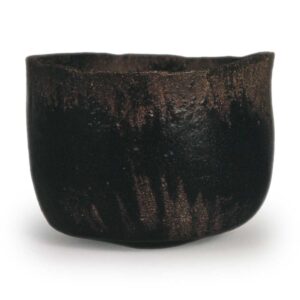
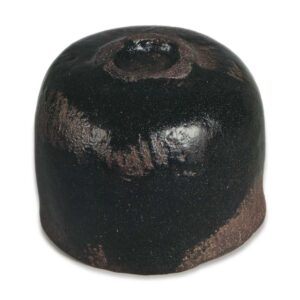
Important Cultural Property
Height: 8.8cm
Diameter: 11.7-21.3cm
Base diameter: 6.1cm
The name “Amagumo” (rain cloud) is thought to have been given to this tea bowl because of the way the glaze and the design of the rim resemble a sudden downpour or a rain cloud.
As a Kōetsu-made Kuro Raku tea bowl, Shigure, Amagumo, Tetsubeki and Shichiri have been highly valued since ancient times. Tetsubeki and Shichiri are the same shape, and Shigure and Amagumo have the same style. Unfortunately, it is said that Tetsubeki was destroyed in the Great Kanto Earthquake. In addition, although I have seen one or two other black tea bowls that are the same shape as Shichiri, as far as is known, these two tea bowls are the only ones of the Shigure and Amagumo shapes, and as Raku ware tea bowls, they can be said to be the only tea bowls of the original form of Koetsu.
Like Shigure, Amagumo is a tea bowl with a very low foot, but while Shigure’s foot is low and has been carved out in the shape of a foot, this tea bowl is almost like a go-sutsu-doko (a type of container used to hold go stones), with a slightly raised foot, and the characteristic feature is that the foot has been carved in a round shape, with the marks of the eyes still visible.
The shape of the strongly curved waist and the area from the body to the rim is almost the same as that of Shigure, but while Shigure is generally a little more compact from the body to the top, Amagumo is slightly narrower at the rim and the rim is slightly turned up.
The rim is strongly worked in a horizontal pattern, giving the appearance of having been cut flat, but the shigure is not as strongly worked, and is more gently carved out. Furthermore, the gentle undulations around the rim are particularly striking in this tea bowl.
With the exception of the inside and outside rims and parts such as the body, waist and foot ring, the black Raku glaze is applied thickly, and the glaze has melted well to form a jet-black color, probably due to the fact that it was fired at a high temperature. The most distinctive feature of the glaze is the way the fire marks appear slightly slanted on the rim and the bottom of the body, giving it the appearance of rain clouds.
The unglazed parts of the piece have a texture that looks like iron skin, but there are two theories today among experts and even among potters as to whether the so-called “fire marks” were created by the glaze naturally flying off in the kiln, or whether they were created intentionally from the start there are two theories, even among experts, and among potters, Raku Kichizaemon says it was naturally scattered, while the skilled Koetsu copyist Yamada Sogo believes it was artificially scraped off.
As for the rainclouds, both theories are possible, but in the case of the Shigure, it probably looks like something that was scattered in the kiln. If the rainclouds were scraped off artificially, it would be a very deliberate glazing, but the fire marks around the waist and the fire marks on the side of the foot ring look a little too deliberate.
The overall thickness is thicker than the Shigure, and there are both thick and thin parts, so it is not uniform. There is no tea pool in the interior, and it has been widely and deeply carved out, as with other Koetsu tea bowls.
There is a crack in one place from the rim to the body.
On the inside of the lid of the paulownia wood box, there is a note written by Sen Sōsai Gensō, “Koetsu Kuro Chawan Mei Uun Sasa (signature)”, and the note on the front of the lid, “Kuro Koetsu Chawan Gensō Sōsai Shofutsu”, is by an unknown author.
The origin of the tea bowl is not clear, but it has long been known to have been in the possession of the Kyomitsu Hachiroemon family.

